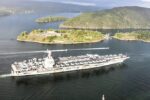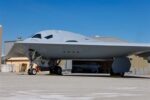The SANCAR armed unmanned surface vessel (USV), a joint development by Türkiye’s Aselsan and SEFT Ship Design under the coordination of the Presidency of Defence Industries (SSB), has successfully completed its acceptance tests. With this milestone achieved in September 2025, the platform is now cleared for delivery to the Turkish Navy. Designed for coastal defense and multi-role littoral operations, SANCAR represents a significant step forward in Türkiye’s growing autonomous naval capabilities.
From Concept to Capability: Development Timeline of SANCAR
SANCAR was initiated as part of Türkiye’s broader push into unmanned maritime systems under the ULAQ and AUSV programs. The project was launched in 2021 with a focus on creating an armed USV optimized for patrol, surveillance, and asymmetric threat deterrence in littoral zones. The design integrates stealthy features with modular payload capabilities to adapt to evolving mission requirements.
Aselsan led the integration of command-and-control systems and weapon payloads while SEFT Ship Design engineered the hull form and propulsion system. Initial sea trials began in mid-2023 at a test range off Antalya. By early 2024, SANCAR had demonstrated autonomous navigation under GPS-denied conditions using inertial navigation systems fused with electro-optical sensors.
Technical Specifications and Combat Systems
SANCAR is a monohull platform measuring approximately 12 meters in length with a displacement around 9 tons. It is powered by dual diesel engines enabling speeds up to 40 knots. The vessel features waterjet propulsion for high maneuverability in shallow waters—critical for operations near coastlines or ports.
Key onboard systems include:
- Remote Weapon Station: A stabilized Aselsan STAMP turret equipped with a 12.7 mm machine gun or optionally a 40 mm automatic grenade launcher.
- C4ISR Suite: Indigenous control architecture enabling line-of-sight (LOS) and beyond-line-of-sight (BLOS) communications via SATCOM or tactical datalinks.
- Autonomy Stack: Capable of semi-autonomous or fully autonomous operation modes including waypoint navigation, target tracking, return-to-base protocols, and obstacle avoidance using LIDAR/EO/IR fusion.
- Sensors: Electro-optical/infrared (EO/IR) suite integrated with automatic target recognition algorithms; optional radar package available depending on mission profile.
Tactical Roles: Littoral Defense and Swarm Operations
The Turkish Navy envisions deploying SANCAR primarily in coastal security roles such as harbor defense, anti-smuggling patrols, reconnaissance missions near disputed maritime zones (e.g., Eastern Mediterranean), and escorting manned platforms through choke points like the Bosphorus Strait.
SANCAR can operate individually or as part of networked swarms coordinated via tactical C2 nodes. In swarm mode—leveraging AI-based collaborative autonomy—it can perform area denial missions against asymmetric threats like fast attack craft or drone boats. This aligns with Türkiye’s doctrine shift toward distributed maritime operations in contested environments.
A Growing Ecosystem of Turkish Naval Unmanned Systems
SANCAR joins other indigenous USVs such as ULAQ (developed by Ares Shipyard & Meteksan) and SALVO under development by STM. While ULAQ emphasizes missile armament including L-UMTAS ATGMs or Cirit rockets, SANCAR focuses on gun-based engagement with lighter logistical footprint suitable for rapid deployment from naval bases or even amphibious ships.
This diversification reflects Türkiye’s strategy to build an ecosystem of interoperable unmanned maritime platforms tailored to specific mission sets—from ISR to strike—to reduce risk exposure to personnel while expanding maritime domain awareness (MDA).
Export Potential and Strategic Implications
The successful completion of acceptance tests positions SANCAR not only as an operational asset but also as an export candidate amid rising global interest in affordable armed USVs. Potential customers include Gulf states seeking littoral security solutions against asymmetric threats such as Houthi drone boats or piracy off East Africa.
Sources within Aselsan have hinted at discussions with Southeast Asian navies exploring modular variants of SANCAR equipped with non-lethal payloads like LRADs or electronic warfare suites tailored for EEZ enforcement without escalation risk.
Conclusion: A Milestone Toward Autonomous Naval Warfare
The readiness of SANCAR underscores Türkiye’s maturation as a developer of indigenous autonomous weapon systems across domains—land (e.g., Barkan UGV), air (e.g., Bayraktar TB3), and now sea. Its integration into fleet operations will offer real-world data on manned-unmanned teaming concepts critical to future naval doctrines globally.









